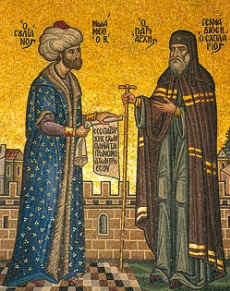
If you read part one, we learned the Ottoman Empire was a really mixed place, in which Christians, Jews, Muslims and even some tribal faiths were ruled under the same government. This would cause difficulty for anyone, so this time we will examine why the Ottoman Empire was actually pretty good at dealing with this issue.
The first thing to remember is where these different religions were located. In what is now Greece, and a lot of Western Turkey, you had Greek Orthodox residents. These people were Orthodox Christians (similar to Russia), but there were many more Greeks around the whole of the Mediterranean and the Balkan regions. Then, there were the Armenian Orthodox people, who lived near Eastern Turkey – in and around what is now called Armenia. Of course, there were Muslims, and they were located all over the Empire. This was particularly true in the Middle East and North Africa, and the Ottoman Empire held onto Mecca for many centuries. Finally, there were the Jews, who lived all over the Empire. Constantinople/Istanbul was the place that all of these people lived in great numbers, and in very close proximity to one another.
The way the Ottomans dealt with these people was through the “Millet” system. This was set up in the mid-15th Century, and lasted until the late 19th Century. This system meant that the Orthodox Christians, Jews and Armenians all had a special protected status, provided they paid a special tax. These people were “Dhimmi” people – the Muslim elite stated that as these people were still people of the book (or Bible), they had a society and civilization that should not be damaged, because they were not savages. Therefore, the religious leaders of that particular Millet could govern over their area without too much interference from the Sultan (basically the Emperor).
This system was very advanced for the time, as it was one of the first systems for genuine religious toleration. Of course, Muslims had special rights and privileges. But efforts were made to get Christians and Jews to convert to Islam, and many did, because of the greater opportunities for career advancement that it offered. This system lasted for a long time, but the rise of nationalism in the 19th century meant that the system (which was based on religion, not ethnicity) was no longer going to work.
Although the varying communities lived in some degree of peace for a long time, Christians in Western Europe thought that their Ottoman counterparts were horribly oppressed by barbaric Muslims. In a way, this basic idea dates back to the Crusades, but the printing press and the newspaper spread these views much more quickly. After Greece gained independence from the empire in 1831, mass media in Western Europe began to issue louder cries for other Christians to rise up, particularly on the basis of nationalism. This nationalism is what put the Ottoman Empire into a fast decline, and the end of the Empire meant less religious toleration. The most well-known incident of this was the Armenian Genocide, a massacre of around a million people beginning in 1915. The main motive for this was Turkish nationalism, which differed from Ottoman policy because it began to see religious minorities as a potential threat to the government.
On that tragic note, we conclude our survey of religion in the Ottoman Empire. If you want to read more about the end of the Ottoman Empire, see my articles on modern Greece – after all, Greece was the first country to gain independence from the Ottomans!
Image from: https://en.wikipedia.org/wiki/Ottoman_Empire#/media/File:Gennadios_II_and_Mehmed_II.jpg

0 Comment:
Be the first one to comment on this article.